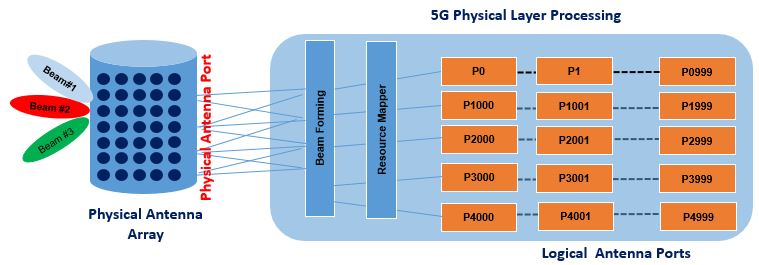5G Antenna Ports | Logical and Physical Antenna Ports
5G Antenna Ports
In 5G NR or 4G LTE, Multiple Input-Multiple Output (MIMO) transmission is a key technology specifically in downlink. Signals transmitted from gNB/eNB via different 5G antennas ports or signals subjected to different and for the receiver unknown, multiple antenna precoding will experience different radio channels even if the MIMO antennas are located at the same site.
In general, it is very critical for a UE to consider the certain assumption in terms of the relationship between the radio channels experienced by different downlink transmissions e.g. UE needs to understand what reference signal(s) should be used for channel estimation for a certain downlink transmission and determine relevant channel-state information required for scheduling and link-adaptation purposes.
For the same reason, the concept of antenna port is used in the 5G NR and it follows the same principles as in 4G LTE. The term “antenna port” is a logical concept related to physical layer (L1), and not the physical one like RF antenna which is visible on tower.
According to 3GPP specification definition, an antenna port is defined such that the channel over which a symbol on the antenna port is conveyed can be inferred from the channel over which another symbol on the same antenna port is conveyed.
In other words, each individual downlink transmission is carried out from a specific antenna port, the identity of which is known to the UE and the UE can assume that two transmitted signals have experienced the same radio channel if and only if they are transmitted from the same antenna port.
In practical, each antenna port, at least for the downlink transmission can be stated as corresponding to a specific reference signal. The UE receiver can assume that this reference signal can be used to estimate the channel corresponding to specific antenna port. The reference signals can also be used by the UE to derive channel-state information related to the antenna port. The set of antenna ports defined in 3gpp specification 38.211 for 5G NR is listed below:
- Dowlink
- PDSCH (Dwonlink Shared Channel): Antenna Port Starting from 1000 (1000 Series)
- PDCCH (Control Channel): Antenna Port Starting from 2000 (2000 Series)
- CSI-RS (Channel State Information): Antenna Port starting from 3000 (3000 Series)
- SS-Block/PBCH (Broadcast Channel): Antenna Port Starting from 4000 (4000 Series)
- Uplink
- PUSCH/DMRS (Uplink Shared Channel): Antenna Port Starting from 1000 (0 Series)
- SRS, precoded PUSCH: Antenna Port Starting from 1000 (1000 Series)
- PUCCH (Uplink Control Channel): Antenna Port Starting from 2000 (2000 Series)
- PRACH (Random Access): Antenna Port Starting from 4000 (4000 Series)
As seen above, there is a defined structure in the antenna port numbering such that the antenna ports used for different purposes must have numbers in different ranges. For example, downlink antenna ports starting with 1000 are used for PDSCH. Different transmission layers for PDSCH can use antenna ports in this series, for example, 1000 and 1001 for a two-layer PDSCH transmission. It should be noted that an antenna port is an abstract concept that does not necessarily correspond to a specific physical antenna port.
Mapping of Antenna Ports to Physical Antenna Ports
There is no strict mapping of antenna ports to physical antenna ports in NR as well as in LTE. As in Release 8 LTE the support 2×2 and 4×4 MIMO schemes, there is can be assumed that a 1:1 mapping for antenna port 0 to 3 for Cell specific reference signal (C-RS). But in 5G NR the order of MIMO is about 64 x 64 or more and even numbering antenna ports is in thousand, so it can be directly mapped.

The mapping of antenna port to physical antenna is controlled by beam forming as a certain beam needs to transmits the signal on certain antenna ports to form a desired beam. So there is a possibility that two antenna ports mapped to one physical antenna port or a single antenna port mapped to multiple physical antenna ports.
Reference:
- 3GPP TS38.211 5G New Radio — Physical Channels and Modulation
Related Posts
- NR-Primary Synchronization Signal (PSS)
- NR-Secondary Synchronization Signal (SSS)
- 5G NR Reference Signals (DMRS, PTRS, SRS and CSI-RS)
- 5G NR Cyclic Prefix (CP) Design



